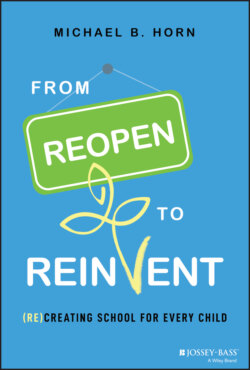Читать книгу From Reopen to Reinvent - Michael B. Horn - Страница 22
NOTES
Оглавление1 1. Mark Lieberman, “Most Students Now Have Home Internet Access. But What About The Ones Who Don't?” Education Week, April 20, 2021, https://www.edweek.org/technology/most-students-now-have-home-internet-access-but-what-about-the-ones-who-dont/2021/04#:~:text=School%20districts%20are%20aware%20much%20more%20work%20needs%20to%20be%20done&text=Still%2C%20the%20report%20estimates%20between,at%20home%20for%20remote%20learning.
2 2. According to Prepared Parents, habits of success encompass a range of mindsets and behaviors, including attachment, stress management, self-regulation, self-awareness, empathy/relationship skills, executive functions, growth mindset, self-efficacy, sense of belonging, believing in the relevance of education, resilience, agency, academic tenacity, self-direction, curiosity, and purpose. Self-direction refers to students being able to drive forward the actions needed to achieve goals, with or without help. Agency refers to the ability of an individual to make their own decisions and act on them. Growth mindset means believing that one can become smarter; they aren't born with a fixed level of smarts. And executive function refers to the ability to concentrate, stay organized, juggle lots of things happening at once, and plan for the future. “Focus on Habits Instead of Test Scores,” Prepared Parents, https://preparedparents.org/editorial/focus-on-16-habits-of-success-not-test-scores/ (accessed November 4, 2021).
3 3. CompetencyWorks, an initiative of the Aurora Institute, has developed an updated definition, as of 2019, of competency-based learning. Their original definition started with a question of what does “high-quality” competency-based learning, not just competency-based learning, look like? The current definition, while dropping the “high-quality” moniker in the report, has retained that emphasis on what good practice of competency-based learning looks like. It has seven parts, which are abbreviated here:
1 Students are empowered daily to make importance decisions about their learning;
2 Assessment is meaningful and yields timely, actionable evidence;
3 Students receive timely, differentiated feedback based on their needs;
4 Students progress based on mastery, not seat time;
5 Students learn actively using different pathways and varied pacing;
6 Strategies to ensure equity for all students are embedded;
7 Rigorous, common expectations for learning (knowledge, skills, and dispositions) are explicit, transparent, measurable, and transferable.
1 See Eliot Levine and Susan Patrick, “What Is Competency-Based Education? An Updated Definition,” Aurora Institute, 2019, https://aurora-institute.org/wp-content/uploads/what-is-competency-based-education-an-updated-definition-web.pdf.
2 4. Barbara Gaddy Carrio, Richard A. DeLorenzo, Wendy J. Battino, and Rick M. Schreiber, Delivering on the Promise: The Education Revolution (Bloomington, IN: Solution Tree Press, 2009), Kindle Locations, pp. 1624–1630.
3 5. “LISTEN—Class Disrupted Podcast Episode 6: Help! My Child and I Are Overwhelmed!,” The 74, June 22, 2020, https://www.the74million.org/article/listen-class-disrupted-podcast-episode-6-help-my-child-and-i-are-overwhelmed/.
4 6. Barbara Pape, “Learner Variability Is the Rule, Not the Exception,” Digital Promise Global, June 2018, https://digitalpromise.org/wp-content/uploads/2018/06/Learner-Variability-Is-The-Rule.pdf.
5 7. This stress is something that has been well documented and is the flip side of the challenges faced by marginalized students and families. See, for example, Alexandra Robbins, The Overachievers: The Secret Lives of Driven Kids (New York: Hyperion, 2007).
